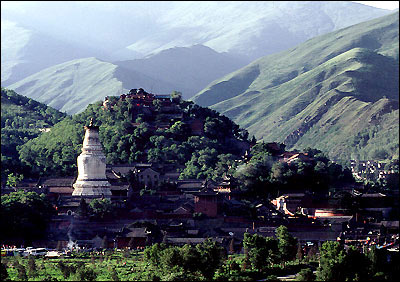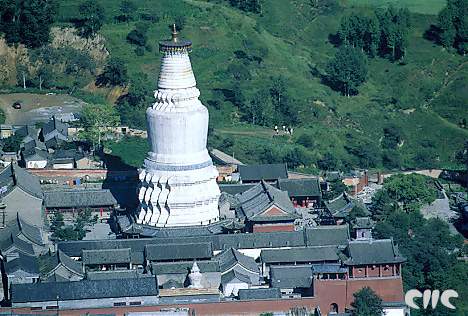Mount Wutai
|
|
|
Mount Wutai was inscribed as a UNESCO World Heritage Site in 2009. |
Mount Wutai, located in Shanxi, is one of the Four Sacred Mountains in Chinese Buddhism. The mountain is home to many of China's most important monasteries and temples. Mount Wutai's cultural heritage consists of 53 sacred monasteries, and they were inscribed as a UNESCO World Heritage Site in 2009. Photo Gallery
Each of the four mountains are viewed as the abode or place of practice of one of the four great bodhisattvas. Wutai is the home of the Bodhisattva of wisdom, Manjusri or Wenshu in Chinese. Mount Wutai also has an enduring relationship with Tibetan Buddhism.
It takes its name from its unusual topography, consisting of five rounded peaks (North, South, East, West, Central), of which the North peak, called Beitai Ding or Yedou Feng, is the highest, and indeed the highest point in northern China.
|
|
|
Temple at Mount Wutai. |
The bodhisattva is believed to frequently manifest himself on the mountain, taking the form of ordinary pilgrims, monks, or most often unusual five-colored clouds.
Mount Wutai is home to some of the oldest existent wooden buildings in China that have survived since the era of the Tang Dynasty (618–907). This includes the main hall of Nanchan Monastery and the East Hall of Fuguang Monastery, built in 782 and 857, respectively. They were discovered in 1937 and 1938 by a team of architectural historians including the prominent early 20th century historian Liang Sicheng. The architectural designs of these buildings have since been studied by leading sinologists and experts in traditional Chinese architecture, such as Nancy Steinhardt. Steinhardt classified these buildings according to the hall types featured in the Yingzao Fashi Chinese building manual written in the 12th century.
|
|
|
Taihuai Town at Mount Wutai. |
Opening hours: 6:30 am – 8 pm
Admission: 168 yuan (from April 1 to October 31), 145 yuan (November 1 to March 31)
Tel: 86-0350-6543133, 6543014 (for complaints)
How to get there:
Take long-distance bus from Liuliqiao Station in Beijing; Take long-distance bus from Yingze Street in Taiyuan
Website: http://www.wutais.cn/index.aspx (Chinese)
 0
0 










Go to Forum >>0 Comments